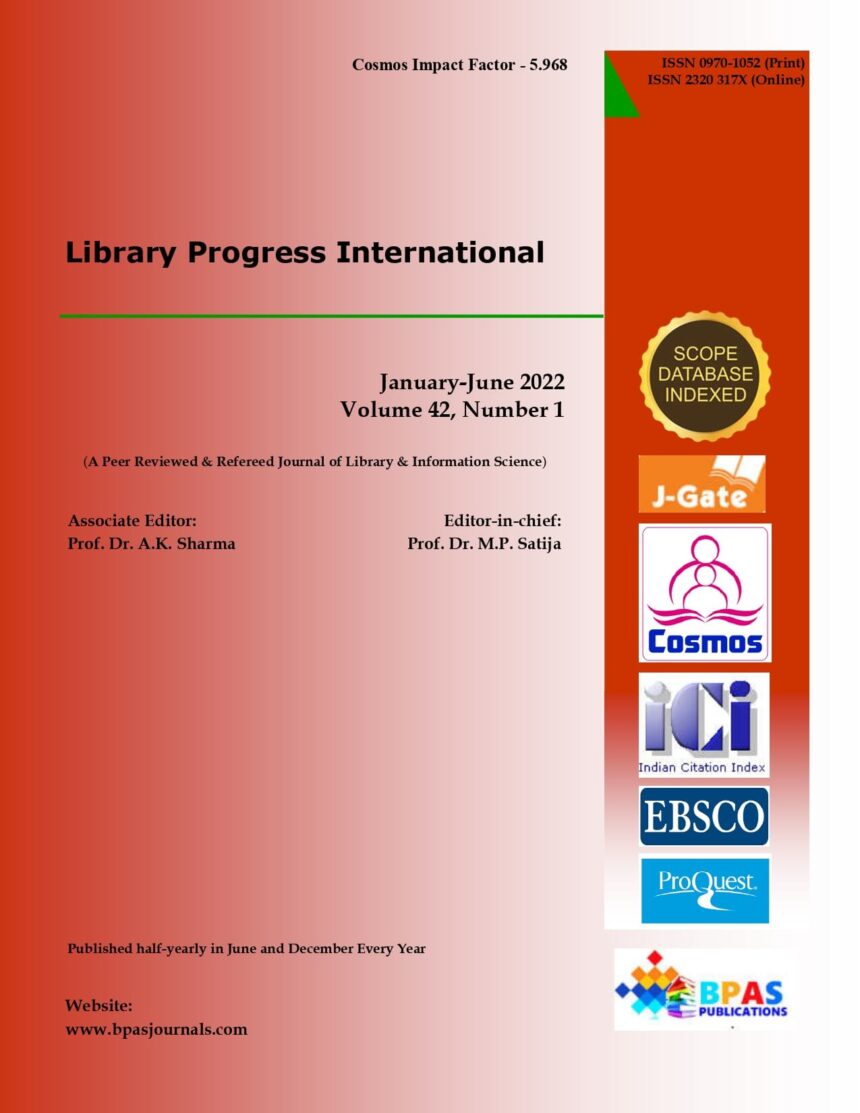The Impact of Twitter Usage among Federal Government Owned University Libraries in South-South Nigeria
DOI:
https://doi.org/10.48165/Keywords:
Twitter Usage, University librariesAbstract
This study investigates the impact of twitter usage among federal government owned university libraries in South-South Nigeria. A descriptive survey method was adopted for the study. A total of one hundred and eight (108) copies of questionnaire were distributed to the librarians in the federal university libraries in South-South, Nigeria, only ninety-five (95) were filled and returned, which was used for study. The instrument for data collection was the questionnaire. Data collected were analyzed using descriptive statistics mean and percentage mean score of 2.5 and above and percentage score of 50% were considered as acceptable by respondents. Its major findings revealed that the impact of twitter usage among federal government owned university libraries in South, South, Nigeria are: to disseminate information, to engage their communities, to engage directly with researchers, creating a virtual service point, scholarly communication for formal and informal learning, free messaging service for researchers and so on. Problem associated with the usage are: Poor adaptation of new technologies by older librarian, poor network coverage, ability to recharge data always, frequent changes in technology, non implementation of twitter policy, and twitter ban in some countries as well as solutions to the usage of twitter in academic libraries which includes adaptation of new technology by older librarian , network should be improve on , recharging of data always is critical , adaptation to change in technology , and proper implementation of twitter policy The study recommended that libraries should adopt the usage of twitter by implementation of twitter policy in university libraries.
Downloads
References
Aharony, N. (2010). Twitter use in libraries: An exploratory analysis. Journal of Web Librarianship, 4(4), 333–350. doi:10.1080/19322909.2010.487766
Barnes, N.G., & Lescault, A.M. (2011) Social media soars as higher experiments and re-evaluates its use of new communications tools. Retrieved fromhttp://www.prweb.com/releases/So
ialMedia/Higher Ed2011/prweb8668892.htm
Booker, L., & Bandyopadhyay, S. (2017). How academic libraries can leverage social networking to popularize their services: An empirical study. Journal of the Indiana Academy of the Social Sciences, 16(2), 129–146. Retrieved fromhttps://digitalcommons.butler.edu/j
iass/vol16/iss2/12/
Cuddy, C., Graham, J. & Morton-Owens, E.G. (2010), "Implementing Twitter in a health sciences library", Medical ReferenceServices Quarterly, vol. 29, no. 4, pp. 320- 330
Del Bosque, D. C., Leif, S. A., & Skarl, S. (2012). Libraries atwitter: Trends in academic library tweeting. Reference Services Review, 40(2), 199–213. Retrieved fromhttps://digitalscholarship.unlv.edu/l
ib_articles/430
Del Bosque, D., Leif, S. A., & Skarl, S. (2012). Libraries atwitter: Trends in academic library tweeting. RSR. Reference Services Review, 40(2), 199–213. doi:10.1108/00907321211228246
Dictionary of Library and Information Science. (2011). A.P.H. Publishing Corporation,4435-36/7, Ansari Road, Darya Ganj New Delhi-110-002
Gunton, L., & Davis, K. (2012). Beyond broadcasting: Customer service, community and information experience in the twitter sphere. Reference services review, 40(2), 224-227. doi:
1108/00907321211228282
Harrison, A., Burress, R., Velasquez, S., & Schreiner, L. (2017). Social media use in academic libraries: A phenomenological study. Journal of Academic Librarianship, 43(3), 248–256. doi:10.1016/j. acalib.2017.02.014 Hendrix, D., Chiarella,
Holmberg, K., & Thelwall, M. (2014). Disciplinary differences in twitter scholarly
communication. Scientometrics, 101(2), 1027–
https://doi.org/10.1007/s11192- 0141229-3.
Kenchakkanavar A. (2015). Facebook and Twitter for academic libraries in the twenty first century. International Research: Journal of Library and Information Science 5(1): 162Bell,
Bell S. (2012). Students tweet the darndest things about your library – and why you need to listen. Reference Services Review,
(2), 217-220. doi:10.1108/00907321211228264 173. 13. Kim, H. M., Abels, E. G., & Yang, C. C. (2012). Who disseminates academic library information on Twitter? Proceedings of the American Society for Information Science and Technology, 49(1), 1–4.doi:10.1002/meet.14504901317
Kimmons, R., & Veletsianos, G. (2016). Education scholars’ evolving uses of twitter as a conference backchannel and social commentary platform. British Journal of Educational Technology, 47(3), 445-464.
Mitchell, A., Holcomb, J., & Page, D. (2013, November). News use across social mediaplatforms. Washington, DC: Pew Research Center. Retrieved fromhttp://www.journalism.org/files/20
/11/NewsUse-Across-Social-Media Platforms1.pdf
Steckenbiller, C. (2016). Am kürzeren Ende der Sonnenallee in 140 characters or less: Using twitter as a creative approach to literature in the intermediate German classroom. DieUnterrichtspraxis/Teaching
German, 49(2), 147–160
Stvilia, B., & Gibradze, L. (2017). Examining undergraduate students’ priorities for academic library services and social media communication. Journal of Academic Librarianship, 43(3), 257–262. doi:10.1016/j.acalib.2017.02.013
Thomas, C. (2005). Millennial net value (s): Disconnects between libraries and the information age mindset. Florida State University, Retrieved fromhttps://www.researchgate.net/profil e/Robert_Mcdonald4/publication/228452 52
Zickuhr, K., Rainie, L. and Purcell, K. (2013). Library services in the digital age. Retrieved February 10, 2014fromhttp://libraries.pewinternet.org/2013/01 / 22/Library-services

